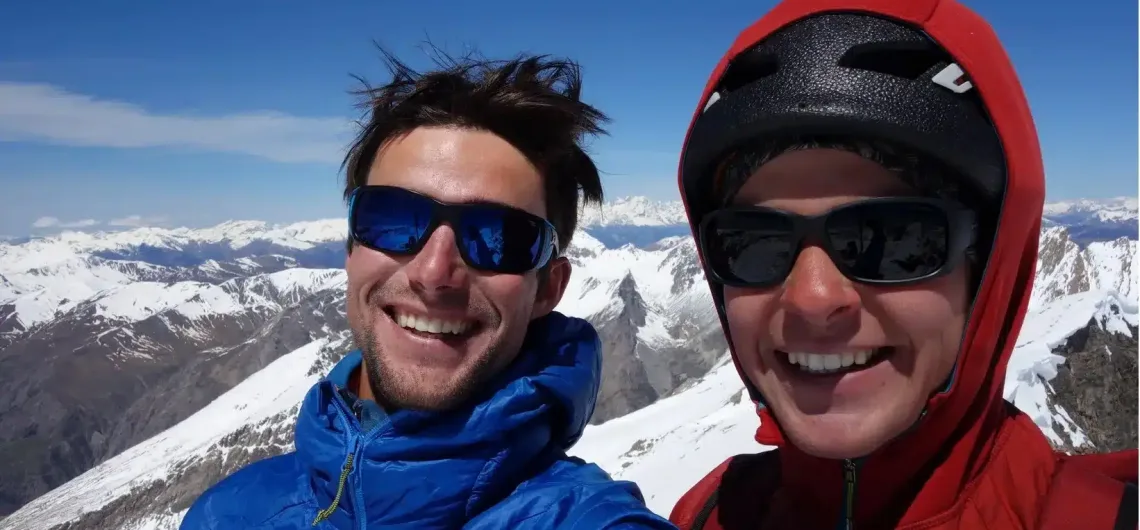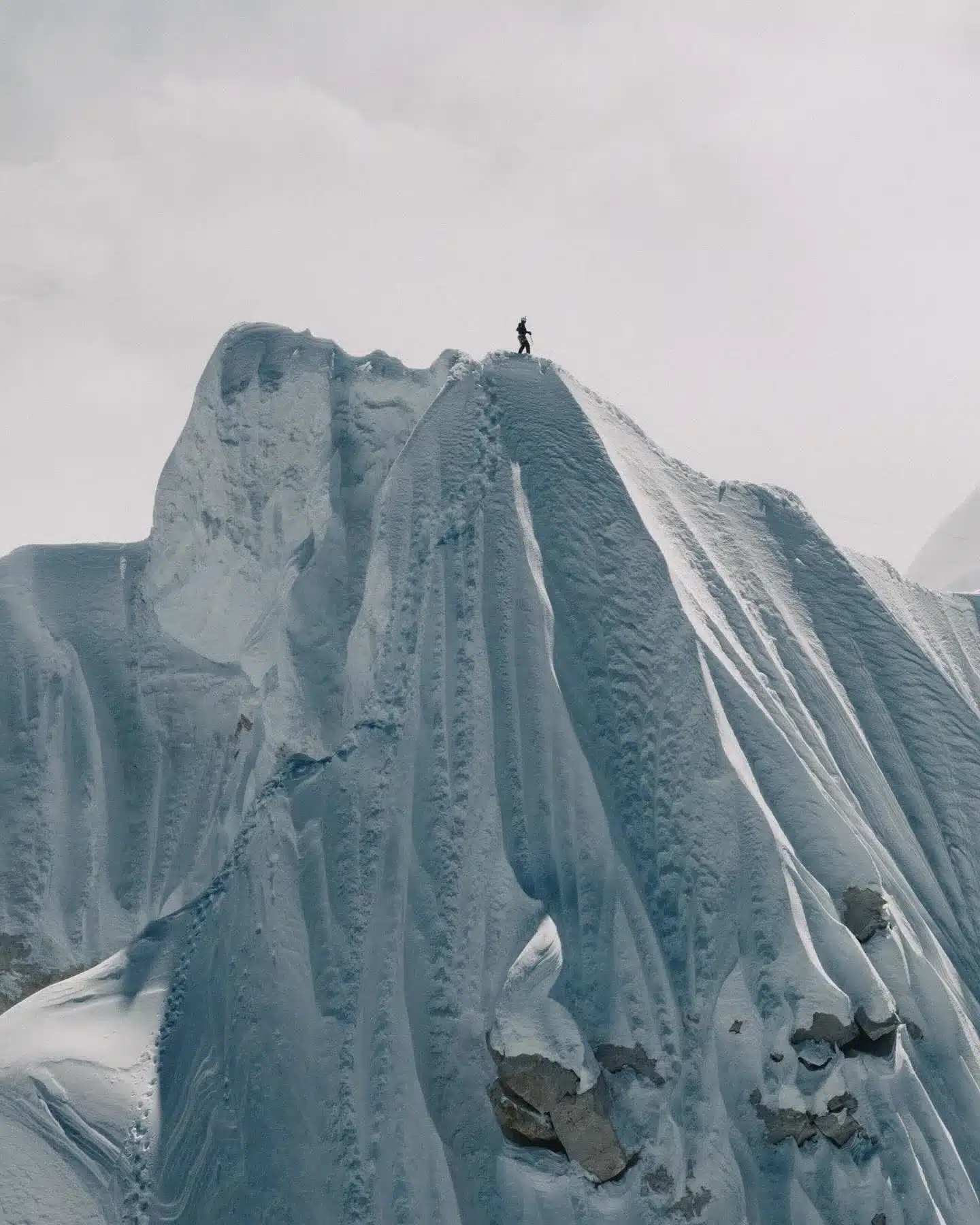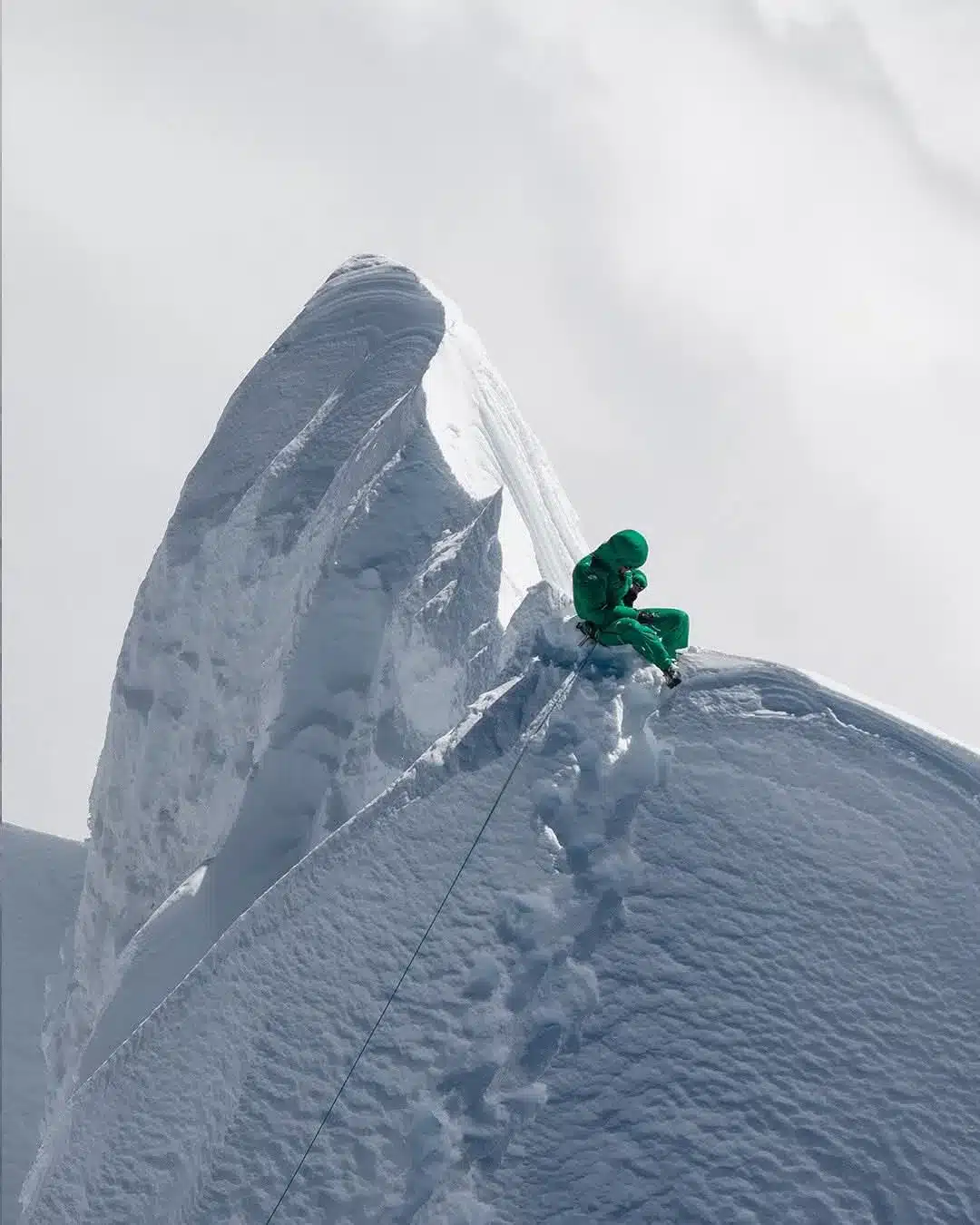Picture this: two men, roped together on a sheer wall of ice and rock that towers over two kilometres high. The wind howls like a wild beast, whipping snow into their faces. Below them, a sea of jagged peaks stretches into the haze, and above, a summit that’s mocked climbers for decades. It’s October 2025 in the heart of the Himalayas, and French alpinists Benjamin Védrines and Nicolas Jean are on the brink of something extraordinary. After years of dreaming, planning, and one heart-wrenching failure, they’ve just crested the final ridge of Jannu East—a 7,468-metre monster that’s stood unclimbed until now.
This isn’t just another tick on a list of high-altitude conquests. Jannu East has been the white whale of Himalayan mountaineering, a peak so steep, so remote, and so riddled with objective dangers that it’s turned back elite teams for over 30 years. Védrines and Jean didn’t just climb it; they pioneered a new route up its North Face via the East Ridge in pure alpine style. No fixed ropes, no siege tactics with porters hauling gear up in stages. Just the two of them, a lightweight rack of gear, and four relentless days of upward grind. They called their line “Top of the Pikes,” a nod to the spear-like spires that guard the summit like ancient sentinels.
For Védrines, it’s the pinnacle of a career built on speed and audacity. “Summiting Jannu East is undoubtedly the greatest achievement of my mountaineering career,” he said later, his voice still thick with emotion. “Climbing such a challenging, long and difficult face in alpine style, on a summit that had never been climbed before, had a profound effect on me. Once we reached the top, after so many trials and tribulations, tears flowed. A dream had come true.”
And for Jean? This climb was a full-circle moment, the capstone to a life spent chasing horizons. “A childhood dream coming true,” he reflected. “A virgin summit, a big face, alpine style, technical mountaineering, and above all a rope companion. We experienced all the ingredients of high-altitude Himalayanism. This ascent also marks the end of my mountaineering career.”
Their story isn’t one of solo glory. It’s a tale of unbreakable partnership, the kind forged in frozen bivouacs and shared silences under starlit skies. The expedition stretched nearly two months, a test of patience as much as physical prowess. They spoke of it as “a collective story,” a heartfelt shout-out to Nepal’s welcoming mountains, their tight-knit circle of friends back home, and every supporter who believed when doubt crept in. In a world where climbing can feel like a solitary battle against gravity, this ascent reminds us it’s the human connections that make the impossible possible.
But let’s rewind. To understand the magnitude of what these two pulled off, you need to know the mountain. Jannu East isn’t your postcard-perfect Everest or K2. It’s a shadowy sibling in the Kanchenjunga massif, tucked away in eastern Nepal’s Kangchenjunga Conservation Area. Rising like a shark’s fin from the Yalung Glacier, it shares a base with its more famous neighbour, Kanchenjunga (8,586m), the world’s third-highest peak. But while Kanchenjunga has seen hundreds of summits since its first ascent in 1955, Jannu East has remained a fortress.
The peak’s allure—and terror—stems from its architecture. Granite buttresses plunge into glacial crevasses, seracs the size of houses teeter on narrow ledges, and avalanches roar down without warning. At 7,468 metres, it’s no lightweight, but its unclimbed status comes from the sheer technical nightmare of its faces. The South Face, attempted in the 1990s by a Polish team, ended in tragedy when a slab of ice buried their high camp. Russian expeditions in the early 2000s probed the West Ridge but retreated amid storms that buried routes under fresh powder. Even in 2024, a Korean squad got within striking distance before high winds shredded their tents and morale.
Jannu East’s history is dotted with near-misses that read like adventure novel cliffhangers. In the 1980s, British climbers eyed its East Ridge, only to be foiled by rotten rock that crumbled under ice axes. A Japanese team in 2010 fixed ropes up 1,500 metres of the North Face, but exhaustion and crevasse falls forced a bailout. By 2025, over a dozen serious pushes had failed, earning it a spot on every alpinist’s “last great problems” list. It’s not just the height; it’s the isolation. Getting there means a nine-day trek from the nearest road in Taplejung, hauling loads through rhododendron forests and bamboo thickets alive with red pandas and langurs. No helicopters for quick evacuations here—just yaks, porters, and sheer willpower.
What makes Jannu East so forbidding? Start with the weather. The Himalayas’ pre-monsoon and post-monsoon windows are narrow, but this corner of Nepal catches the full brunt of jet stream winds that can gust over 100 km/h. Temperatures plummet to -30°C at night, turning ropes brittle and fingers numb. Then there’s the rock: loose, exfoliating granite that laughs at cams and nuts. Mixed terrain demands skills in dry-tooling, where you swing axes into tiny cracks while front-pointing vertical ice. And lurking beneath? A labyrinth of crevasses, some hidden under snow bridges that collapse without a sound.
Yet, for climbers like Védrines and Jean, that’s the draw. The Himalayas have been tamed in many ways—fixed lines on Everest, commercial ops on Manaslu—but peaks like Jannu East keep the wild spirit alive. They’re a reminder that the mountains still hold secrets, routes that demand not just strength, but creativity and humility. When these two Frenchmen set their sights on it, they weren’t chasing fame. They were answering a call that’s echoed in alpinists’ hearts since the golden age of the 1930s: go light, go fast, leave no trace.
To really appreciate their triumph, let’s meet the men behind the helmets. These aren’t faceless pros; they’re storytellers with lives woven into the fabric of the mountains.
 Who is Benjamin Védrines?
Who is Benjamin Védrines?
Benjamin Védrines isn’t just a climber—he’s a force of nature, the kind of guy who turns mountains into playgrounds. Born on June 25, 1992, in the Pyrenees region of southern France, Ben grew up with the jagged silhouettes of the Midi d’Ossau and Vignemale as his backyard. His dad was a ski patroller, mum a teacher, and from a young age, the family weekends blurred into a mix of powder turns and rock scrambles. By 14, Ben was hooked on ski touring, skinning up slopes before dawn to earn those gravity-fueled descents. Climbing came next, a natural evolution. At 16, he ticked off his first big routes in the Alps, linking multi-pitch granite cracks with the ease of someone twice his age.
What sets Védrines apart is his obsession with speed. He’s not content with just summiting; he wants to redefine how fast it can be done. In 2016, fresh out of guide school at Chamonix—where he qualified as an IFMGA mountain guide—he started shattering records. Take Broad Peak (8,051m) in 2022: Ben didn’t just climb it; he flew up the standard route in a blistering 12 hours and 40 minutes from base camp, then paraglided down, slashing the previous fastest ascent by nearly half. That para-launch from 8,000 metres? It was a personal milestone, a way to touch the sky twice in one push. “Being the first to launch from there was huge,” he said at the time. “It’s like giving the mountain a hug before you leave.”
His style is pure alpinism: lightweight, self-sufficient, no supplemental oxygen. Ben’s gear list reads like a minimalist’s dream— a single 60-metre rope, a handful of ice screws, a few quickdraws, and a bivy sack for emergencies. He’s got that wiry build, all lean muscle and endless stamina, honed by years of running trails in the French Alps and cross-country skiing through winter storms. Off the hill, he’s a family man, married with a young kid who already toddles in tiny crampons. Guiding pays the bills—leading clients up Mont Blanc or into the Karakoram—but his heart’s in the bold lines, the ones that scare even the pros.
Védrines’ resume is a highlight reel of audacity. In 2023, he linked the north faces of the Eiger, Matterhorn, and Grandes Jorasses in a 72-hour blitz, a traverse that tested endurance and route-finding on some of Europe’s gnarliest ice. Closer to home, he reclaimed the fastest known time (FKT) on Mont Blanc’s Goûter Route in 2024, skiing up and down in under five hours. But 2025? That’s been his Himalayan hot streak. In May, he and Jean crushed all four faces of Mont Blanc in 21 hours, a vertical marathon of 7,500 metres that left jaws on the floor. Then September rolled around, and they notched the first ascent of Anidesh Chuli (6,808m) in the Rolwaling range—a technical mixed route up a peak barely on the map.
For Ben, climbing isn’t about the ego boost. It’s philosophical. He talks about “keeping the soul of pure alpinism alive,” blending old-school ethics with modern tech like GPS watches and lightweight fabrics. Paragliding is his secret sauce—he’s launched from over 20 summits worldwide, turning descents into flights of freedom. But beneath the speed, there’s depth. Jannu East wasn’t a record chase; it was a pilgrimage. After their failed 2024 bid, where storms pinned them at base camp for weeks, Ben doubled down on training: altitude tents in his garage, yoga for flexibility, and mental drills to steel against the unknown. “It’s not about being the fastest,” he once told a group of young climbers in Chamonix. “It’s about moving with the mountain, not against it.”
At 33, Védrines is at his peak—strong, wise, and hungry for more. Jannu East cements his legacy as a bridge between eras: the speed demons of today carrying the torch lit by Messner and Habeler. But ask him what’s next, and he’ll grin: “The mountains decide. I’m just along for the ride.”
Who is Nicolas Jean?
If Védrines is the spark, Nicolas Jean is the steady flame—the partner who makes the magic happen without stealing the spotlight. Born in the late 1980s in the Savoie region of France, Nico grew up in the shadow of the Écrins National Park, where granite spires pierce the sky like nature’s cathedrals. His path to the sharp end of a rope started young: family hikes turned into solo scrambles, and by his teens, he was belaying mates on multi-day routes in the Calanques. But it was guidance that shaped him. Qualifying as an IFMGA guide in his early 20s, Jean built a rep as the guy you’d want on your rope in a whiteout—calm, precise, unflappable.
Nico’s not one for the limelight. He’s the quiet type, more likely to crack a dry joke over a pot of couscous at camp than pose for selfies. Physically, he’s built like a rugby forward: broad shoulders, tree-trunk legs from years of front-pointing ice, and hands scarred from countless whipper catches. His climbing philosophy? Simplicity. “Gear is just a tool,” he says. “The real work is in your head and your heart.” That mindset shines in his routes: clean lines, no bolts unless absolutely necessary, always with an eye toward leaving the rock cleaner than you found it.
Jean’s achievements stack up like cordwood, but they’re the collaborative kind. In 2023, he teamed with Védrines and Julien Cruvellier de Luze to open “L’Appel du Vide” on the south face of Barre des Écrins—a 1,200-metre mixed monster graded M7 that snaked through overhanging roofs and chandeliered ice. It was one of the last great unclimbed lines in the French Alps, a testament to his eye for untapped potential. Fast-forward to 2024, and he was part of a rescue squad in the Himalayas, hauling an injured American climber to safety after a partner’s fatal fall. No headlines for that one—just quiet heroism, the sort that binds the climbing community tighter.
What really forges Jean’s legend is his partnership with Védrines. They’ve been roped together for half a decade, a duo that clicks like clockwork. Their 2025 Mont Blanc extravaganza—skiing and climbing all four iconic faces (Aiguille du Midi, Col du Géant, Goûter, and Brenva) in 21 hours—was pure poetry. Starting at midnight under a full moon, they linked couloirs and seracs in a vertical dance, descending on skis that whispered through fresh powder. “It’s like reading each other’s thoughts,” Nico said afterwards. “Ben leads the charge; I make sure we don’t crash.”
But Jean’s Himalayan chapter is where the depth shows. In October 2024, he and Ben probed Jannu East’s lower flanks, fixing lines through a maze of crevasses, only to get stormed out. It could’ve broken lesser men, but Nico saw it as fuel. Back in France, he threw himself into prep: glacier courses in the Mer de Glace, dry-tooling sessions on indoor walls, and long talks with Sherpa friends about the mountain’s moods. Then, in September 2025, they bagged Anidesh Chuli—a 1,000-metre new route up rotten slabs and blue ice that felt like a warm-up for the main event.
At 36, Jean’s announcing retirement after Jannu East feels right, like hanging up the boots after a perfect run. Climbing’s been his lifeblood since boyhood, those starry nights dreaming of far-off peaks while staring at maps pinned to his wall. But family calls now—a wife who’s his rock, kids who need a dad present for more than postcards. “I’ve tasted it all,” he reflects. “The fear, the joy, the brothers-in-arms. Time to pass the torch.” Yet, knowing Nico, he’ll still guide, still mentor wide-eyed kids in Chamonix. He’s the anchor who holds the line steady, reminding us that true strength is in the support, not the spotlight.
The Road to Jannu: Dreams, Doubts, and a Failed Bid
Every epic has its prologue, and for Védrines and Jean, it starts in a smoky Kathmandu teahouse in early 2024. Over plates of dal bhat and endless cups of masala chai, they pored over topo maps of the Kanchenjunga region. Jannu East had haunted them for years—Ben first spotted its shark-fin profile in a dog-eared guidebook at 20, Nico sketched it in his journal during a rainy layover in Lukla. It wasn’t the height that drew them; it was the unknown. A virgin summit in an era where Google Earth has mapped every crag.
Prep was meticulous. Months of base training in the Alps: circuit runs up the Aiguilles Rouges, weighted hikes with 20-kilo packs, and yoga flows to keep hips loose for those awkward mixed moves. Gear was dialed— Black Diamond cams, Petzl axes with modular picks, La Sportiva G2 boots insulated for -40°C. They even tested a new bivy setup: a two-man tarp strung between ice screws, light enough to stash in a daypack. Nutrition? High-carb gels for the push, electrolyte tabs to fight the dehydration that sneaks up at 7,000 metres.
The team was lean: just the duo, plus a skeleton crew of Nepali support. No army of porters; alpine style meant carrying their own world. Permits secured through the Nepal Mountaineering Association, they flew to Biratnagar, then jeeped to Suketar. From there, the trek began—a nine-day slog through terraced hills alive with the scent of cardamom and the chatter of magpies. Yaks hauled barrels of kerosene and sacks of rice, while local porters in flip-flops bounded ahead with loads that would crush a Westerner.
Base camp nestled at 4,500 metres on the Yalung Glacier, a windswept flat of moraine and melt pools. Tents went up under the shadow of Jannu Himal (7,731m), its west face a glittering cascade of icefalls. The North Face of Jannu East loomed across the valley, a 2,300-metre curtain of grey rock streaked with blue veins. First recon: a week of probing the lower glacier, dodging crevasses wide as streets. They fixed 500 metres of rope through the bergschrund—a gaping fissure where the face meets the icefield—using 8mm cords that could be jümared up on the push.
But the mountains had other plans. A freak low-pressure system rolled in, dumping two metres of snow in 48 hours. Winds stripped canvas from tents; avalanches thundered down the face, burying their fixed lines under slabs. Pinned at base, they watched dreams dissolve in whiteout. “It was like the peak was saying, ‘Not yet,'” Ben recalled. Nico spent nights sketching alternative lines in a battered notebook, while Ben paced, burning energy on snowshoe runs. After 40 days, with frostbite nipping at toes and supplies dwindling, they pulled the plug. The flight home was silent, the kind where you stare out the window and wonder if you’ll ever return.
Failure stings, but for these two, it sharpened the blade. Back in France, they debriefed over beers in a Chamonix pub: What gear failed? Where did the weather windows close? They tweaked the plan—lighter packs, better weather routing via satellite apps—and hit the reset button. By spring 2025, with Mont Blanc and Anidesh Chuli under their belts, the fire reignited. Kathmandu again, this time in August. The trek felt familiar, almost comforting, as if the hills remembered them. Base camp redux: same spot, but with a renewed edge. The face looked meaner, its seracs more precarious, but so what? They’d come to dance.
 The 2025 Expedition Unfolds
The 2025 Expedition Unfolds
August 2025 dawned clear in the Kanchenjunga valley, a rare gift from the gods. Védrines and Jean arrived at base camp lean and mean, packs stripped to 12 kilos each for the push. The support crew—cook Pasang, liaison officer Gyan, and a handful of Sherpas—waved them off with khatas (blessing scarves) and cries of “Jai Bhagwati!” The duo crossed the Yalung on snowshoes, the glacier creaking like old floorboards under their weight.
Advanced base at 5,200 metres was a snow hole hacked from a serac’s lee side. Here, they stashed a depot: extra food (freeze-dried dal and chapati), a medical kit stocked with dexamethasone for swelling brains, and a VHF radio for check-ins. Nights were cold symphonies—wind whistling through nylon, the distant rumble of ice calving. Mornings brought boot-black frost on beards and fingers too stiff to zip jackets. But the stars? Unbelievable. The Milky Way arced like a river of diamonds, with Kanchenjunga’s massif a black silhouette against the glow.
The wait was the real grind. Himalayan weather is a cruel tease—bluebird days dissolving into lenticular clouds by noon. They filled time with yoga salutes on the glacier, reading tattered paperbacks by headlamp, and deep talks about life beyond the rope. Ben shared stories of his daughter’s first steps; Nico confessed fears about leaving the mountains for fatherhood. Trust deepened, the kind that lets you sleep while your partner leads into the void.
October 13: Go time. A slim window per the forecasts—four days of stable highs before the jet stream returned. They jümared their old fixed lines, now dusted but holding, and breached the bergschrund at dawn. The North Face hit like a freight train: 45-degree snowfields giving way to 70-degree ice smears. Axes thunked into brittle turquoise, crampons scraping granite nubbins. By nightfall, 600 metres up, they hacked a ledge for the bivy—two body widths wide, with a snow wall for wind block. Dinner was a shared bar of chocolate and sips from a thermos of milky tea. Sleep came in fits, the face groaning around them.
Day two blurred into verticality. The East Ridge proper beckoned—a sinuous arete of knife-edge snow flanked by cornices the size of cars. They simul-climbed where possible, Ben leading pitches of AI5 ice while Nico trailed, ready to catch a slip. Rock bands forced detours: overhanging dihedrals where they dry-tooled past loose flakes the size of briefcases. A close call mid-afternoon—a hold blew, yanking Ben off-balance—but Nico’s belay held like iron. “That’s why we climb together,” he grunted, hauling in slack. Camp two at 6,400 metres: a wind scoop on the ridge, views stretching to Everest’s plume 100 kilometres south.
Exhaustion crept in by day three. Altitude clawed at lungs—every breath a rasp, headaches pulsing like drumbeats. The face steepened to 80 degrees, mixed terrain demanding creative aid climbing: skyhooks on bomber flakes, torqued tools in seams thinner than pencils. An avalanche whispered past at noon, a powder cloud that dusted their helmets. They pressed on, the summit pyramid now in sight—a cluster of pikes like the teeth of some primordial beast. Bivy three: a mere dent in the ice, bodies curled fetal under a single bag. Dreams were feverish—falling, flying, summits slipping away.
Summit Push: Tears on the Top of the Pikes
October 16 dawned pink and still, the kind of light that makes you believe. At 3 AM, crampons crunched as they broke camp, headlamps carving tunnels in the dark. The final 1,000 metres were a gauntlet: a 90-degree ice hose that ate screws like candy, followed by a rocky headwall laced with verglas. Ben took the sharp end, his breaths measured, axe swings metronomic. Nico seconded with quiet encouragement: “Breathe easy, brother. We’re almost there.”
By 10 AM, the pikes loomed—three granite thorns guarding the true summit. The last pitch was a choose-your-poison: a chimney of flaring cracks or an exposed traverse under a teetering block. They went chimney, stemming with knees and elbows, packs snagging on chockstones. At 11:30, Ben crested the final col. There it was: a cairn-sized platform, prayer flags fluttering in a ghost breeze. Jannu East, conquered.
They embraced, helmets clinking, tears freezing on lashes. No whoops or fist pumps—just raw, wordless joy. The view? Indescribable. Kanchenjunga filled the north, its glaciers threading like silver veins. South, the Arun Valley snaked toward the plains, a green haze 5,000 metres below. They lingered 20 minutes—snapping photos with a battered GoPro, leaving a small trinket (a French flag pin) in the snow. Descent was the real dragon: down-climbing unroped where possible, rapps off snow mushrooms rigged with slings. By dusk, they staggered into base camp, ghosts in the machine, greeted by cheers and hot soup.
- Doug Scott Tribute: The first Englishman to summit Mount Everest
- Tenzing Norgay, the first sherpa to summit Mt. Everest
- Reinhold Messner, first human to summit Everest solo without supplemental oxygen
- Sir Edmund Hillary and Tenzing Norgay, the first persons to climb to the summit of Mount Everest
![]()




Comments